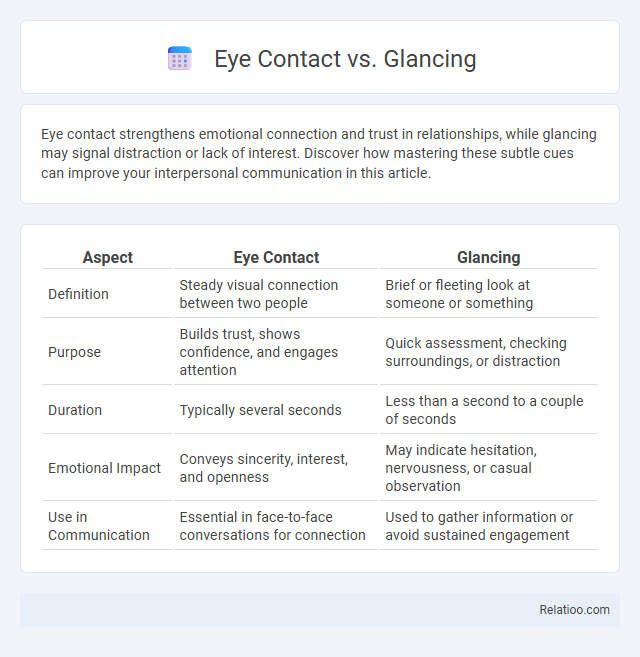Eye contact strengthens emotional connection and trust in relationships, while glancing may signal distraction or lack of interest. Discover how mastering these subtle cues can improve your interpersonal communication in this article.
Table of Comparison
| Aspect | Eye Contact | Glancing |
|---|---|---|
| Definition | Steady visual connection between two people | Brief or fleeting look at someone or something |
| Purpose | Builds trust, shows confidence, and engages attention | Quick assessment, checking surroundings, or distraction |
| Duration | Typically several seconds | Less than a second to a couple of seconds |
| Emotional Impact | Conveys sincerity, interest, and openness | May indicate hesitation, nervousness, or casual observation |
| Use in Communication | Essential in face-to-face conversations for connection | Used to gather information or avoid sustained engagement |
Defining Eye Contact and Glancing
Eye contact involves maintaining steady visual connection between individuals, signaling attention, trust, and engagement, while glancing is a brief, often unconscious look that captures fleeting information without sustained focus. Defining eye contact highlights its role in effective communication, emotional connection, and social interaction, whereas glancing serves more as a quick, situational visual check. Understanding the distinction between eye contact and glancing is essential for interpreting nonverbal cues in personal and professional contexts.
The Psychology Behind Eye Contact
Eye contact plays a crucial role in nonverbal communication by signaling attention, confidence, and emotional connection, while glancing typically indicates distraction or discomfort. The psychology behind eye contact reveals its power to influence trust and social bonding, as sustained eye contact activates brain regions associated with empathy and understanding. Mastering your eye contact can enhance interpersonal interactions and convey sincerity and engagement effectively.
Social Meanings of a Glance
A glance typically conveys fleeting attention or subtle interest, distinct from prolonged eye contact which signals engagement or confidence in social interactions. Unlike eye contact, a glance can indicate hesitation, discomfort, or an attempt to observe without drawing attention. Understanding the social meanings of a glance enhances communication by interpreting nonverbal cues related to feelings such as curiosity, avoidance, or discreet acknowledgment.
Cultural Differences in Eye Contact and Glancing
Cultural differences significantly influence the interpretation of eye contact and glancing, affecting social interactions worldwide. In Western cultures, maintaining direct eye contact is often associated with confidence and honesty, whereas in many Asian and Indigenous cultures, prolonged eye contact may be seen as disrespectful or confrontational. Understanding these nuances helps you navigate cross-cultural communication effectively by respecting varied norms around eye engagement.
The Role of Eye Contact in Building Trust
Eye contact plays a crucial role in building trust by signaling attentiveness, sincerity, and confidence, which helps establish a genuine connection with others. Unlike glancing or fleeting eye contact, sustained and meaningful eye contact encourages openness and credibility in personal and professional interactions. You can enhance trustworthiness by maintaining consistent eye contact, aligning your intentions with nonverbal communication cues.
When Glancing Signals Disinterest
Glancing often signals disinterest by indicating fleeting attention and lack of engagement, contrasting with eye contact that conveys connection and focus. Sustained eye contact establishes trust and active listening, while brief or repeated glances away may reflect distraction or discomfort. Understanding these subtle differences helps decode nonverbal cues in social and professional interactions.
The Impact of Eye Contact in Communication
Eye contact plays a crucial role in communication by conveying confidence, sincerity, and engagement, while glancing often signals distraction or discomfort. Maintaining steady eye contact helps build trust and rapport, fostering deeper interpersonal connections and effective message exchange. In contrast, inconsistent or brief eye contact can lead to misunderstandings and diminished perceived credibility in social or professional interactions.
Avoiding Misinterpretation: Eye Contact vs Glancing
Maintaining steady eye contact conveys confidence and sincerity, while glancing often signals distraction or discomfort, which can lead to misunderstandings in communication. You should focus on consistent eye contact to ensure your message is perceived as honest and engaged, avoiding misinterpretation that occurs when glancing is mistaken for disinterest or evasiveness. Clear differentiation between these visual cues establishes stronger interpersonal connections and fosters trust.
Eye Contact and Professional Interactions
Eye contact establishes trust and confidence in professional interactions by signaling attentiveness and respect, whereas glancing may convey distraction or insecurity, potentially undermining communication effectiveness. Maintaining consistent eye contact helps reinforce active listening and engagement, crucial for building rapport and credibility in the workplace. Studies show that professionals who master eye contact tend to achieve better collaboration and negotiation outcomes.
Tips for Mastering Eye Contact and Glancing
Mastering eye contact involves maintaining steady, natural gazes that convey confidence and engagement, typically lasting 3 to 5 seconds before briefly breaking away. Glancing, by contrast, requires quick, subtle eye movements to gather information without signaling discomfort or distraction. Practice balancing these techniques by holding intentional eye contact during conversations and using brief glances to assess your surroundings or emphasize points without overwhelming your audience.

Infographic: Eye contact vs Glancing
 relatioo.com
relatioo.com